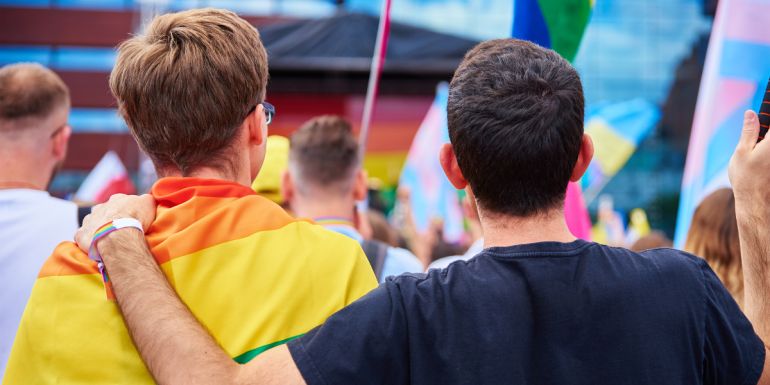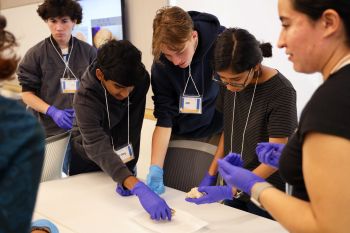Written by Megan Rouse, Communications Associate, UCLA Center for the Developing Adolescent
Adolescence is an important time in development when young people learn to navigate the world around them and forge a deeper sense of who they are and how they matter in the world. For young people who identify as a sexual minority, including lesbian, gay, bisexual, and transgender youth (LGBTQ+), discrimination and harassment in their schools, communities, and sometimes even families can make this process more challenging.
This month, in honor of Pride, we spoke with NSCA member Stephen Russell about the research on how to support young people who identify as LGBTQ+ in ways that enhance their own health and well-being, which also benefits the communities where they live.
LGBTQ+ Youth Need Support
Large and long-term efforts to track adolescent well-being, like the Add Health study and the ABCD Study, have given us insights into how we can best support the development, health, and well-being of young people from various populations, including the LGBTQ+ community. These studies have shown us that LGBTQ+ young people can thrive during adolescence, but discrimination based on sexual orientation or gender identity can lead to higher rates of physical and mental health challenges, including higher rates of depression, anxiety, and suicidal ideation, compared to youth who identify as heterosexual and cisgender.
According to the Trevor Project 2024 survey, 60 percent of LGBTQ+ adolescents reported that they have felt discriminated against in the past year due to their sexual orientation or gender identity.
One of the pioneering researchers who studies LGBTQ+ population trends over time is Dr. Stephen Russell, a member of the National Scientific Council on Adolescence and professor at the University of Texas at Austin. His research has shown that environments play a significant role in the outcomes for these young people, and ensuring that these environments meet the needs of LGBTQ+ young people can lead to positive outcomes.
“What I have been able to do is use population data from lots of places to document the kinds of health trends we care about preventing for kids, and then link that to the policies and practices that make a difference,” says Stephen.
Creating Environments for LGBTQ+ Youth to Thrive
All adolescents have the same developmental needs for supportive families and caring adults, peers, and messages that let them know they belong. When these needs are met, they can support positive development and health outcomes for LGBTQ+ youth.
Families
Even as we exercise more autonomy and independence in adolescence, we still need support from our families and other caring adults to help us grow our sense of identity, build resilience, and support positive mental health. For LGBTQ+ youth, family acceptance leads to higher self-esteem and general health. One 2021 study found that LGBTQ youth whose families affirm their gender identity and sexual orientation are almost 50 percent less likely to make a suicide attempt compared to those whose families are unsupportive.
Peers
Peers also play a role in positive outcomes during adolescence, when our increased sensitivity to social rewards makes the feeling of social acceptance or rejection particularly powerful. Research suggests that having strong, supportive friends increases positive identity development and protects against depression for LGBTQ+ youth. In one study, youth who had their chosen name used and respected in multiple contexts, including by peers, had reduced depressive symptoms and suicidal ideation.
Public discourse
Additionally, during adolescence, our need to feel respected and our heightened sensitivity to feeling disrespected can amplify painful feelings from discrimination and exclusion. Anti-LGBTQ+ rhetoric and messaging can not only hurt sexual minority youth but can also compound the problem by encouraging discrimination from communities and peers. In one study by Stephen and his colleagues, the negative discourse around Prop 8 in California, a law legalizing gay marriage, actually increased homophobic bullying in schools without an LGBTQ+ support in place. And, in 2024, 90 percent of LGBTQ+ young people said their well-being was negatively impacted due to recent political messaging against the LGBTQ+ community.
Schools
Creating safe and inclusive schools and educational settings is important for the healthy growth and development of all young people, but it can also be a protective factor for young people who identify as LGBTQ+. After decades of research into the intersection of health trends and policies, Stephen and other researchers created an evidence-based framework to help schools better protect and support young people who identify as LGBTQ+.
This framework includes four key pillars:
- Policies and practices should be inclusive and supportive of LGBTQ+ youth. Antibullying policies that are inclusive of sexual orientation and gender identity are associated with stronger feelings of safety, less victimization, and lower rates of suicidal behavior among LGB youth. LGBTQ-focused policies are associated with less psychological distress and depressive symptoms, and greater general well-being among LGBTQ youth during adolescence. Inclusive policies were also associated with more positive experiences and perceptions of school climate for LGB youth.
- Adults and professionals should be trained to work with sexual minority youth. When LGBTQ+ youth feel supported by school personnel, they report higher feelings of belonging, less absenteeism, and achieve higher grade point averages. Training teachers and administrators on how to be more inclusive and about the unique needs of LGBTQ+ youth could promote better mental health and academic outcomes for young people. Additionally, competency training should be given to health professionals to foster appropriate, informed, and inclusive care for LGBTQ+ youth.
- Youth should be encouraged and supported to create their own positive and accepting spaces. Empowering young people to create their own environments, in the form of clubs, teams, or communities, can encourage peer relationships, build leadership skills, and decrease bullying in schools. Some studies suggest that having a LGBTQ-focused club on campus, such as a GSA, can lead to academic and health benefits for LGBTQ+ and heterosexual students.
- LGBTQ+-related resources and curriculum should be available for all young people. Youth feel safer in their schools when they have access to accessible resources such as books, digital resources, and lectures that discuss and provide information about LGBTQ+ people, along with a curriculum that discusses LGBTQ+ individuals and movements. Additionally, students who have learned about LGBTQ+ topics at school report less bullying, less absenteeism, and less gender-based bullying.
Conclusion
All young people need safe and supportive environments to grow, explore, and learn, but we know from evidence that it is especially important for sexual minority youth, who are more likely to face discrimination and harassment. In recent years, we have seen an increase in the kinds of LGBTQ+ policies that we know create barriers to positive health and well-being.
“The very things we know to make a difference are being legislated out,” says Stephen. “We know that there is evidence and that we’re going in the wrong direction of that.”
It is critical that we use what we have learned from decades of research about supporting our young people to inform the policies and programs that affect them. Creating better school climates, inclusive laws, and providing support for sexual minority youth helps ALL young people.
Find more resources on supporting LGBTQ+ youth:
- Stories and Numbers: A resource designed to help students, parents, and school personnel understand and use the best available research to create safe and supportive schools.
- GSA Network: The national Genders & Sexualities Alliances Network works to help bring GSAs to schools and communities across the country.
- Supporting Positive Development for LGBTQ Youth: A group of resources from the UCLA Center for the Developing Adolescent, including research-based ways to support sexual minority youth.
- We Support Transgender Youth: A Statement and Framing Guidance: A resource from Frameworkd Institute and the UCLA Center for the Developing Adolescent on how to effectively communicate about transgender youth.



_350_233_80_c1.jpg)